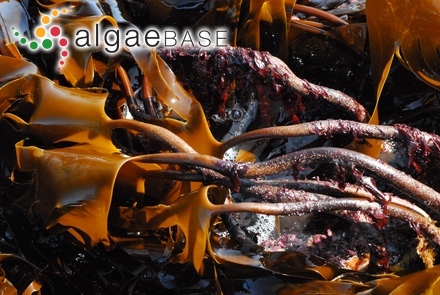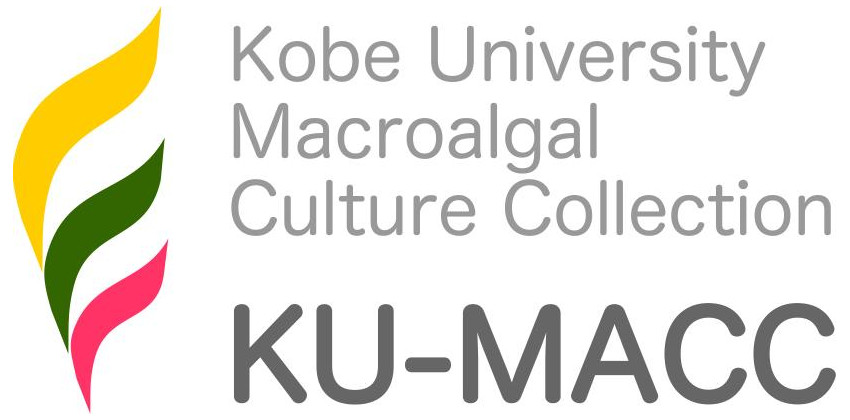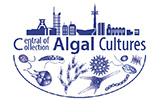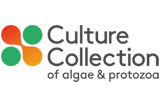Palmaria palmata (Linnaeus) F.Weber & D.Mohr 1805

Current name:
Palmaria palmata (Linnaeus) F.Weber & D.Mohr
Black Head, Co. Clare, Ireland; plants on exposed stipes of Laminaria hyperborea at ELWS - 28 April 2006. Michael Guiry (mike.guiry@nuigalway.ie)
Publication Details
Palmaria palmata (Linnaeus) F.Weber & D.Mohr 1805: 256, 259, 299, 300
Published in: [Weber, F. & Mohr, D.M.H.] (1805). Einige Worte über unsre bisherigen, hauptsächlich carpologischen Zergliederungen von kryptogamischen Seegewächsen. Beiträge zur Naturkunde 1: 204-329.
Type Species
The type species (lectotype) of the genus Palmaria is Ceramium palmatum (Linnaeus) Stackhouse.
Status of Name
This name is of an entity that is currently accepted taxonomically.
Basionym
Fucus palmatus Linnaeus
Type Information
Type locality: ""Ad oras atlantica""; (Linnaeus 1753: 1162) Lectotype: L; 910.184.2889 (Irvine & Guiry 1983: 68) Notes: Linnaeus's description was taken from Van Royen (1740) and a lectotype has been selected from his herbarium (which Linnaeus examined).
Origin of Species Name
Adjective (Latin), lobed or divided in the manner of an outspread hand with the sinuses between the lobes pointing to the place of attachment (Stearn 1983).
General Environment
This is a marine species.
Description
Reddish brown, membranous or leathery, flattened fronds, 50-300 (-1000) mm long, arising from a discoid base, usually with a small stipe expanding gradually to form simple or dichotomously and palmately divided fronds, often with characteristic marginal leaflets. Blade very variable in shape, having broadly ovate to narrowly linear segments.
Habitat
Marine. On rock, mussels and epiphytic on several algae, intertidal (at all levels but particularly near low water) and shallow subtidal , especially on upper part of Laminaria hyperborea stipes (to a depth of 5 m), widely distributed, abundant. Undivided or sparingly divided forms occur on mussels on exposed shores and sometimes in the subtidal (to 20 m in exceptionally clear water); plants growing on exposed shores, known in Ireland as Creathnach, are considered to be more palatable than the leathery plants of the lower intertidal of semi-exposed shores, which are usually dried and sold as Dillisk or Dilleasc; these forms may ultimately prove to be a separate entity. A very finely dissected form grows epiphytically on rocks, pedbbles and Fucus serrratus in the sheltered parts of semi-exposed shores where silt or fine sand accumulates; this is sometimes known as the "var. sobolifera" or "var. sarniensis" and is much less common than the other forms.
Key Characteristics
The palmate branching with its finger-like extensions is very characterstic; most plants have marginal proliferations at the base. Young plants can be less leathery and may be thin and slippery.
Similar Species
The finely-divided forms are sometimes misidentified as Gracilaria multipartita, the latter is, however, much thicker, and recognisably fleshy.
Created: 30 March 1996 by M.D. Guiry.
Last updated: 06 June 2024
Verification of Data
Users are responsible for verifying the accuracy of information before use, as noted on the website Content page.
Nomenclatural note
Initially this binomial was ascribed to Stackhouse (1801) and later to Kuntze (1891), but the earliest valid use of the name is that of Weber & Mohr (1805) (fide Athanasiadis 22 March 2010, e-mail). - (15 July 2010) - M.D. Guiry
Taxonomic note
Morton (1994) includes "Palmaria palmata var. sobolifera" from Northern Ireland, a combination that has not been validated; this entity (formerly Rhodymenia palmata var. sobolifera) is currently considered to be included in the type variety. - (11 May 2006) - G.M. Guiry
Distributional note
Probably confined to the North Atlantic. Reports from India and the Philippines and elsewhere are incorrect. Reports from the Pacific, particularly Japan, probably refer to other species of the genus. The occurrence of this cold water species in the Gulf of Guinea is also unlikely (John et al., 2004). - (11 May 2006) - G.M. Guiry
Usage note
This is a common red seaweed found between the tides on rocky shores and is named for its resemblance to the palm of the human hand (Latin, palma). In Ireland, Scotland and England, it is known as Dillisk or Dulse. In Irish, two names are used: Creathnach (feminine) and Duileasc (masculine). These names actually express different forms of what appears to be a single biological entity. Creathnach is a smaller, narrower form that generally grows on small mussels on wave-swept shores, and is sometimes known as "Shell-dulse" in English; this form is more popular in many places. Duilleasc, on the other hand, is used for a larger, broader form that grows directly on rocks or on kelp.
The use of dulse is known in Ireland since at least the twelfth century when it was mentioned in a poem describing the duties of monks:
Seal ag buain duilisg do charraig,
seal ag aclaidh,
seal ag tabhairt bhídh do bhoctaibh,
seal i gcaracair.
A while gathering dillisk from the rock,
a while fishing,
a while giving food to the poor,
a while in a cell.
Regulations governing the collection of dulse were introduced in Iceland in the thirteenth century, and the Icelandic sagas (eleventh century onwards) describe one of the heroes being given dulse in milk to lull him into sleep prior to being killed.
Dulse is good to eat, but generally only after being dried. In a fresh state it is leathery and unpalatable. After sun-drying and proper storage, it is a very pleasant plant to chew. It has very little fat and only a small amount of proteins and cellulose, but is very rich in trace elements and vitamins, particularly vitamin A. Dulse contains large amount of several unusual carbohydrates including an unusual short-chained one, floridoside, and this can form up to 30% of the dry weight. This may account for its palatability.
Scotland, Norway, Iceland and eastern Canada all produce small amounts of dulse for human consumption. In Ireland about 20 dry tonnes are sold each year, mainly in the west and north-east. It is particularly popular in the working class areas on north Belfast where its use is likely to have come, along with the name 'dulse' from Scotland. At present natural dulse is in short supply.
All sorts of claims are made for dulse. According to a herbal published in Dublin in 1726 (Threlkeld's Synopsis stirpium hibernicarum…, as Fucus palmam humanam referens):
"But in Dublin men chew it like Tobacco when dry, carrying it in their Pockets for that end, which destroys worms, and gives a Relish to Beer, as Anchoves and Olives to Wine; it is commended against Women's longing."
The matter of it being a vermifuge may be due to the kainic acid content. Dulse used to be sold in the Galway Egg and Butter Market and was reputed to be an good remedy for a hangover; it is still occasionally sold in vegetable and fishmonger shops in Galway. Nowadays, dulse is often used in chowders and fish dishes, as a condiment, and even in desserts and bread. - (11 May 2006) - G.M. Guiry
Linking to this page: https://www.algaebase.org/search/species/detail/?species_id=1
Citing AlgaeBase
Cite this record as:
Pier Kuipers in Guiry, M.D. & Guiry, G.M. 06 June 2024. AlgaeBase. World-wide electronic publication, National University of Ireland, Galway. https://www.algaebase.org; searched on 28 March 2025
 Request PDF
Request PDF














